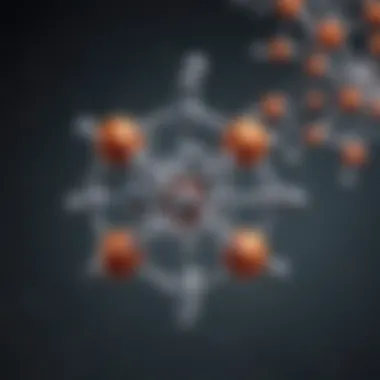Exploring Vanadium: Properties and Applications


Intro
Vanadium is a transition metal known for its distinct chemical properties and versatility in various applications. As the world faces increasing energy demands and environmental challenges, examining vanadium's role becomes essential. This overview delves into the fundamental aspects of vanadium, including its properties, extraction methods, uses across different industries, and its environmental impact.
The exploration of vanadium is particularly relevant today. As sustainable practices gain momentum, the metal's applications in renewable energy solutions are transforming industries. It plays a crucial part in battery technologies and other innovative applications that could address pressing global issues. Understanding vanadium's characteristics and implications is integral for students, researchers, educators, and professionals aiming to navigate the evolving landscape of energy resources and environmental awareness.
Research Overview
Summary of Key Findings
This examination reveals several critical findings about vanadium:
- Vanadium possesses unique properties, such as high strength-to-weight ratio and corrosion resistance.
- The extraction methods for vanadium primarily involve the roasting and leaching of vanadinite ores.
- Its applications extend from steel manufacturing to the development of vanadium redox flow batteries.
- Environmental considerations highlight the need for sustainable extraction methods to minimize ecological impacts.
Importance of the Research
The significance of this research rests on its multifaceted analysis. By outlining vanadium's properties and practical applications, the discussion informs industry professionals about viable uses of the metal. Additionally, it emphasizes the environmental concerns associated with vanadium extraction, advocating for responsible practices in handling the resource. The findings can aid in shaping future innovations in renewable energy technologies, which is a crucial step towards global sustainability efforts.
Methodology
Study Design
The research design employed a mixed-methods approach, combining qualitative and quantitative data sources to deliver a comprehensive perspective on vanadium. The focus was on gathering a broad range of literature from scientific studies, industry reports, and expert articles, ensuring a rigorous examination of the subject.
Data Collection Techniques
Data collection encompassed multiple techniques:
- Literature review to synthesize existing knowledge.
- Case studies to illustrate practical applications of vanadium.
- Interviews with industry experts to gather insights on environmental considerations and future trends.
- Statistical analysis of production and consumption data to highlight trends in vanadium use.
This methodology ensures a well-rounded understanding of vanadium's properties, uses, and the environmental issues tied to it, providing valuable insights for future research and industry practices.
Overview of Vanadium
Vanadium is a transition metal with unique properties that make it valuable in various industrial applications. Understanding its characteristics is crucial for recognizing its role in modern technology and materials science. This section provides a foundational overview of vanadium, highlighting its chemical and physical properties, which are key to its utility and significance in multiple sectors.
Chemical Properties
Vanadium exhibits a range of interesting chemical properties. It has an atomic number of 23 and is placed in group 5 of the periodic table. The metal typically exists in several oxidation states, including +2, +3, +4, and +5, with +5 being the most stable and common in compounds. Its versatility emerges from its capacity to form various types of compounds, including oxides, chlorides, and sulfides. These compounds often exhibit differing levels of reactivity and stability.
One notable compound, vanadium pentoxide (V2O5), is widely used as an industrial catalyst in chemical reactions, particularly in the production of sulfuric acid. Vanadium oxides, especially V2O5, are also crucial in catalyzing oxidation reactions in the manufacture of chemical products. Furthermore, vanadium reacts easily with oxygen, particularly at elevated temperatures, forming a protective oxide layer that can enhance its corrosion resistance.
Physical Characteristics
In addition to its chemical properties, vanadium's physical characteristics play an important role in its applications. The metal is silver-gray in color and has a relatively high melting point, approximately 1910 degrees Celsius. It possesses a good degree of malleability and ductility, which enables it to be shaped and formed into various structures without cracking.
Vanadium displays significant strength, particularly when alloyed with other metals. It improves the hardness and tensile strength of steel, making it a sought-after component in alloy production. As such, vanadium alloys are utilized in sectors requiring materials with both durability and lightweight properties, such as aerospace engineering and automotive manufacturing.
"Vanadium’s unique properties not only enhance strength in steel but also play a crucial role in catalysis and energy applications."
Overall, a deep understanding of vanadium's chemical properties and physical characteristics lays the groundwork for exploring its applications and environmental implications. Its multifaceted nature requires careful consideration when evaluating its extraction, usage, and potential future developments.
Historical Context


The historical context of vanadium is essential to understand its significance in both scientific discovery and industrial applications. This section explores how vanadium was discovered, named, and used through time, reflecting the evolution of its applications and its growing importance in technology. The history of vanadium not only informs us about its chemical and physical properties but also sheds light on societal advancements in metallurgy, energy production, and other fields.
Discovery and Naming
Vanadium was discovered in 1801 by the Spanish scientist Andrés Manuel del Río. He initially named it " erythronium," due to its red-colored salts. However, after further experimentation and challenges in isolating the element, other scientists, including the famous chemist Dmitri Mendeleev, did not recognize del Río's findings, leading to confusion in the scientific community. It was not until 1830, when Swedish chemist Nils Gabriel Sefström re-discovered the element and named it "vanadium," based on the Scandinavian goddess of beauty, Vanadis. This naming reflected the element’s vibrant variety of colored compounds. The initial skepticism and eventual recognition of vanadium mark an essential chapter in the history of chemistry.
Historical Uses
Historically, vanadium was not widely utilized until the late 19th century, when it began to be recognized for its beneficial alloying properties in steel. Vanadinite, a mineral containing vanadium, was initially used as a pigment in ceramic glazes. As industrial demands grew, so did vanadium's potential applications. Its strength-enhancing abilities in steel soon led to its incorporation in various alloys.
The significance of vanadium became prominent during the early 20th century when its application in tool steels and high-strength, low-alloy steels gained traction. Vanadium alloys offered improved strength, hardness, and wear resistance. Consequently, its role expanded in high-performance applications, such as aerospace and military industries, where robust materials were essential.
"The discovery and applications of vanadium highlight the continuous interplay between scientific exploration and technological advancement."
By understanding this historical context, one can appreciate the journey of vanadium from discovery to its current status as a key component in modern materials science and energy solutions.
Sources and Extraction
Understanding the sources and extraction of vanadium is crucial for its application in various industries. Vanadium is largely extracted from minerals in which it occurs naturally. Its significant utility in steel production and as a component in batteries accentuates the importance of efficient and sustainable extraction methods. Moreover, this knowledge aids in assessing environmental impacts linked to its sourcing and utilization.
Natural Occurrences
Vanadium is not commonly found in its native form due to its reactivity. Instead, it is usually present in minerals, such as vanadinite and carnallite. The concentration of vanadium in these ores is generally low, necessitating substantial processing to extract usable quantities.
Countries like Russia, China, and South Africa are leading producers, with the majority of vanadium resources situated in iron ores. In fact, vanadium is often recovered as a by-product in the processing of titaniferous magnetite or through methods involving copper extraction.
In natural settings, vanadium can be found in different forms, including:
- Vanadate minerals: These are the primary ores containing vanadium.
- Residuary deposits: Resulting from weathering processes, where vanadium becomes concentrated.
- Biological presence: Some organisms, like certain algae, can incorporate vanadium into their cellular structures, although this is a less common occurrence.
The diverse natural occurrences of vanadium influence its extraction routes and economic viability.
Extraction Techniques
Vanadium extraction techniques vary depending on the source and the concentration of vanadium in the ore. These methods are designed to optimize recovery while minimizing environmental impact. Here are some commonly employed techniques:
- Pyrometallurgical methods: Involves smelting the ore to separate vanadium from impurities using high heat. This method is often effective but can be energy-intensive.
- Hydrometallurgical processes: This technique makes use of water-based solutions to extract vanadium from ores. It generally produces a less contaminating waste by-product but may offer lower extraction rates than pyrometallurgical approaches.
- Biotechnological methods: Emerging strategies focus on using microorganisms for the recovery of vanadium from spent catalysts and residues. While this is still in development, it holds potential for eco-friendly extraction practices.
The choice of extraction method is critical. It impacts product purity, processing costs, and environmental sustainability. Given the increasing demand for vanadium due to its use in modern technologies, particularly in renewable energy, the exploration of new extraction techniques and improvements in existing methods becomes imperative. This addresses not only efficiency but also the broader implications of vanadium's environmental footprint.
"Selecting appropriate extraction methods is key to balancing economic viability with environmental responsibility in vanadium processing."
Industrial Applications
Vanadium plays a vital role in various industrial applications, largely due to its unique properties and versatility. Its contribution spans multiple industries including metallurgy, chemicals, and energy. Understanding vanadium's applications helps us appreciate its significance in modern technology and manufacturing processes. This section covers the most notable uses of vanadium in steel production, chemical manufacturing, and renewable energy solutions.
Vanadium in Steel Production
Vanadium is integral to the production of high-strength steel. The addition of vanadium enhances the strength and toughness of steel, making it ideal for construction and automotive applications. This process involves adding small amounts of vanadium during the manufacturing of steel alloys. The key characteristic of vanadium in this context is its ability to form strong carbides.
- Benefits of Using Vanadium:
- Increased yield strength.
- Enhanced ductility.
- Resistance to corrosion.
The influence of vanadium in steel production cannot be overstated. It improves the performance and longevity of steel products, facilitating advancements in sectors that rely on durable materials.


Usage in Chemical Manufacturing
In chemical manufacturing, vanadium is primarily used as a catalyst in the production of sulfuric acid. This is critical in the manufacture of fertilizers, dyes, and explosives. The capacity of vanadium to promote chemical reactions significantly improves production efficiency.
- Chemical Benefits:
- Facilitates oxidation reactions.
- Reduces energy consumption in processes.
- Increases yield of desired products.
Its catalytic properties make vanadium a sought-after element in various chemical processes, essential for meeting global production demands in a variety of sectors.
Role in Renewable Energy
Vanadium's role in renewable energy technologies is emerging as a determining factor in global energy strategies. This section explores its applications in energy storage technologies, particularly through vanadium redox flow batteries and broader energy storage solutions.
Vanadium Redox Flow Batteries
Vanadium redox flow batteries (VRFBs) are distinctive due to their ability to store energy for extended periods. This type of battery allows for scalable energy storage, addressing intermittent supply issues prevalent in renewable energy sources such as solar and wind.
- Key Characteristic:
- Long cycle life compared to traditional batteries.
The unique feature of VRFBs lies in their flexibility. They can be adjusted to store more energy simply by increasing the size of storage tanks. This aspect offers a significant advantage, especially for large-scale renewable energy facilities aiming for efficiency and longevity.
"Vanadium redox flow batteries stand out for their ability to decouple power from energy, addressing critical challenges in renewable energy storage."
Energy Storage Solutions
Energy storage solutions utilizing vanadium are gaining attention in both commercial and residential markets. They offer reliable backup power and enhance grid stability through demand response initiatives.
- Key Benefit:
- Increased reliability and reduced energy costs.
The unique feature of these solutions is their modular approach, making them suitable for varying energy needs. However, the higher installation cost compared to other battery technologies can be a barrier to widespread adoption.
Health and Safety
Health and safety considerations are paramount when working with vanadium due to its various applications in different industries. Understanding the toxicological data and occupational exposure limits associated with vanadium is essential for ensuring the safety of workers and the environment. This section addresses the intrinsic risks posed by vanadium and outlines necessary precautions, thereby promoting a culture of safety in industries handling this element.
Toxicological Data
Research indicates that vanadium compounds can be toxic when subjected to high levels of exposure. While elemental vanadium is less toxic, certain compounds like vanadium pentoxide show significant toxicity. Toxicological data emphasizes the potential health effects, which may include respiratory issues, skin irritations, and possible effects on the neurobehavioral system.
- Respiratory Issues: Exposure to dust or fumes can lead to respiratory sensitization and other chronic respiratory conditions.
- Dermatological Reactions: Skin contact with vanadium compounds can result in dermatitis or more severe reactions.
- Systemic Effects: High concentrations may affect systemic organs, with reports of vanadium influencing liver and kidney function.
Continuous monitoring and assessment of these toxicological values is crucial for workplaces involving vanadium. The data serves not only to notify of potential dangers but also to guide regulations and safety practices.
Occupational Exposure Limits
Occupational exposure limits (OELs) for vanadium determine the maximum allowable concentration of vanadium in the air for workers in industrial environments. Various organizations recommend specific limits:
- American Conference of Governmental and Industrial Hygienists (ACGIH): They suggest a threshold limit value (TLV) of 0.05 mg/m³ for vanadium pentoxide.
- Occupational Safety and Health Administration (OSHA): OSHA has set a permissible exposure limit (PEL) of 0.5 mg/m³ for vanadium pentoxide over an 8-hour shift.


These established limits are critical for mitigating health risks in workplaces.
"Understanding the permissible exposure limits is essential for protecting worker health and preventing potential adverse effects of vanadium exposure."
Regular air sampling and employee training on safe handling procedures can help maintain these limits. Implementing and adhering to these guidelines enables organizations to foster a safer work environment.
Environmental Impact
The environmental impact of vanadium is a critical aspect that requires thorough exploration, considering the growing importance of sustainability. As industries increasingly rely on this metal, it is imperative to assess how its extraction and use affect ecosystems and contribute to environmental challenges. Specifically, this section addresses the implications of extraction practices, recycling initiatives, and how vanadium's lifecycle plays a role in ecological sustainability.
Impact of Extraction Practices
The extraction of vanadium is often associated with significant environmental challenges. Mining operations, particularly for vanadium-rich ores, can result in habitat destruction, soil erosion, and contamination of water resources. For example, vanadium is mainly obtained from vanadinite, a mineral found in various deposits, including some that may threaten local biodiversity. The processes used in extraction, such as pyrometallurgical and hydrometallurgical methods, can generate toxic byproducts, leading to air and water pollution.
Moreover, the extraction practices may produce waste materials that are hazardous to local flora and fauna. Proper management of tailings is essential to minimize environmental degradation. Implementing best practices in mining operations can help reduce the negative impacts.
Key considerations include:
- Reducing energy consumption during extraction
- Protecting surrounding ecosystems
- Implementing stricter regulations on mining practices
"Sustainable extraction of vanadium is not just an environmental responsibility; it is a necessity for the future of our planet."
Recycling and Sustainability
Vanadium possesses unique properties that make it well-suited for recycling. Recycling vanadium can significantly reduce the demand for new material extraction, alleviating some of the environmental pressures associated with traditional mining. The use of vanadium in applications such as steel production and energy storage systems particularly benefits from recycling practices.
The recycling process involves collecting used materials containing vanadium, such as steel scrap, and subjecting them to refining processes to reclaim the metal. This not only conserves natural resources but also reduces wastewater and energy expenditures associated with primary production.
Sustainability initiatives that focus on vanadium recycling have several advantages:
- Lower carbon footprint compared to virgin material production
- Mitigation of landfill waste
- Conservation of energy and resources
By integrating recycling into the lifecycle of vanadium, industries can enhance their sustainability efforts. This alignment with circular economy principles ensures that vanadium is used more efficiently, allowing it to fulfill its potential in diverse applications while minimizing environmental harm.
Future Trends
The exploration of future trends in vanadium is essential in understanding how this element will influence various industries and environmental practices. As we face global demands for cleaner energy and sustainable materials, vanadium's role grows increasingly pivotal. The emerging applications and advancements in technology suggest a transformative impact on sectors such as renewable energy and aerospace.
Next-Generation Applications
Advancements in Battery Technology
Advancements in battery technology are crucial for enhancing energy storage systems. Vanadium is particularly valuable due to its use in vanadium redox flow batteries (VRFBs). These batteries offer the distinctive advantage of scalability, permitting larger installations without a significant loss in efficiency.
One key characteristic of VRFBs is their ability to deliver a consistent power output over extended periods. This stability makes them a beneficial choice for renewable energy applications, such as solar and wind. Unlike conventional batteries, VRFBs can be charged and discharged simultaneously, which adds to operational flexibility.
However, these batteries are not without disadvantages. Their initial investment is higher compared to lithium-ion alternatives. The complexity of the system might also deter some potential users. Yet, the longevity and safety features of vanadium redox flow batteries present compelling advantages that align well with the goals of sustainable energy solutions.
Emerging Uses in Aerospace
The aerospace sector is increasingly recognizing the potential of vanadium in developing lighter and stronger materials. Alloys containing vanadium improve the strength-to-weight ratio, which is vital for aircraft efficiency.
A notable characteristic of vanadium in aerospace applications is its capability to enhance corrosion resistance. This property is advantageous when aircraft operate in diverse and harsh environments. The potential for improved performance and reduction in fuel costs makes vanadium-infused alloys an attractive option for manufacturers.
Nonetheless, challenges such as the cost of raw materials and production complexity cannot be overlooked. Nevertheless, the unique features of vanadium in aerospace applications could provide significant long-term benefits, resulting in improved safety and reduced environmental impact.
Policy and Regulation
The future of vanadium is also influenced by policy and regulatory frameworks. Governments and institutions should consider sustainable practices focused on vanadium use. This includes regulations that encourage research and development for innovative applications while ensuring environmentally friendly extraction processes.
By fostering a supportive regulatory environment, the potential for vanadium to contribute to a more sustainable future can flourish, reinforcing its importance across all discussed domains.



